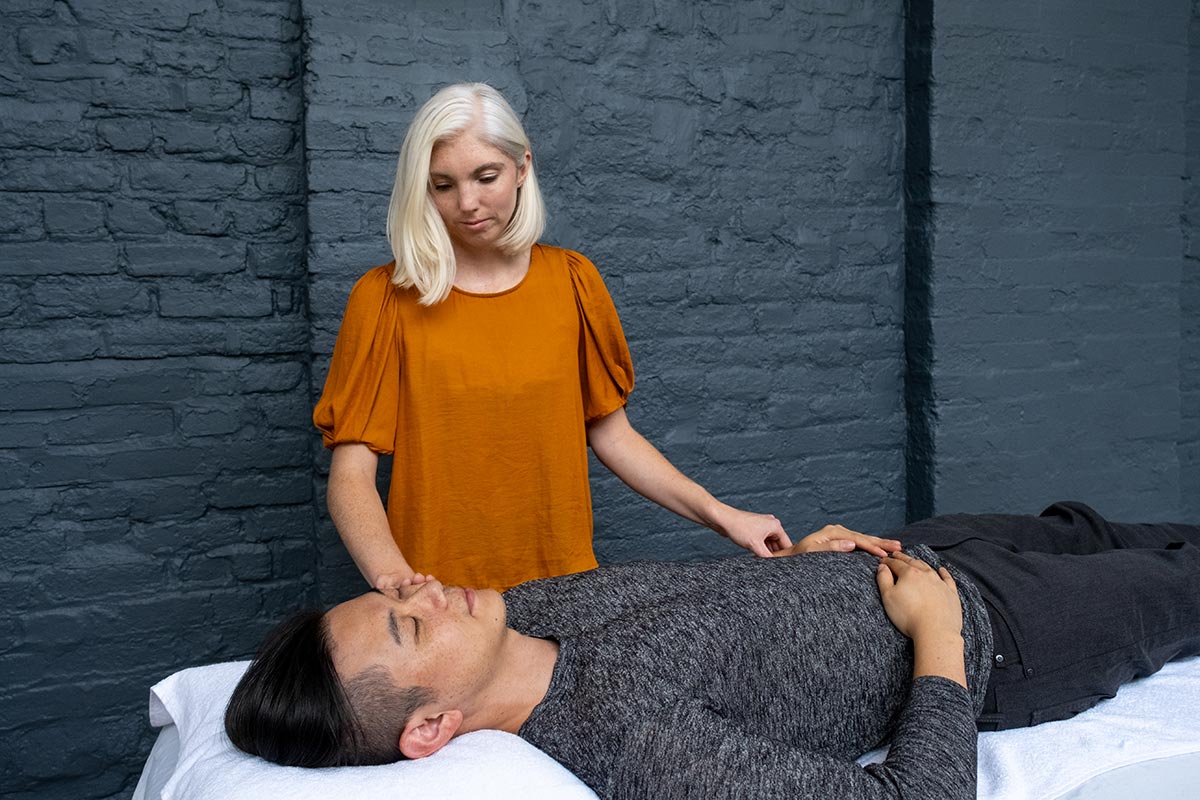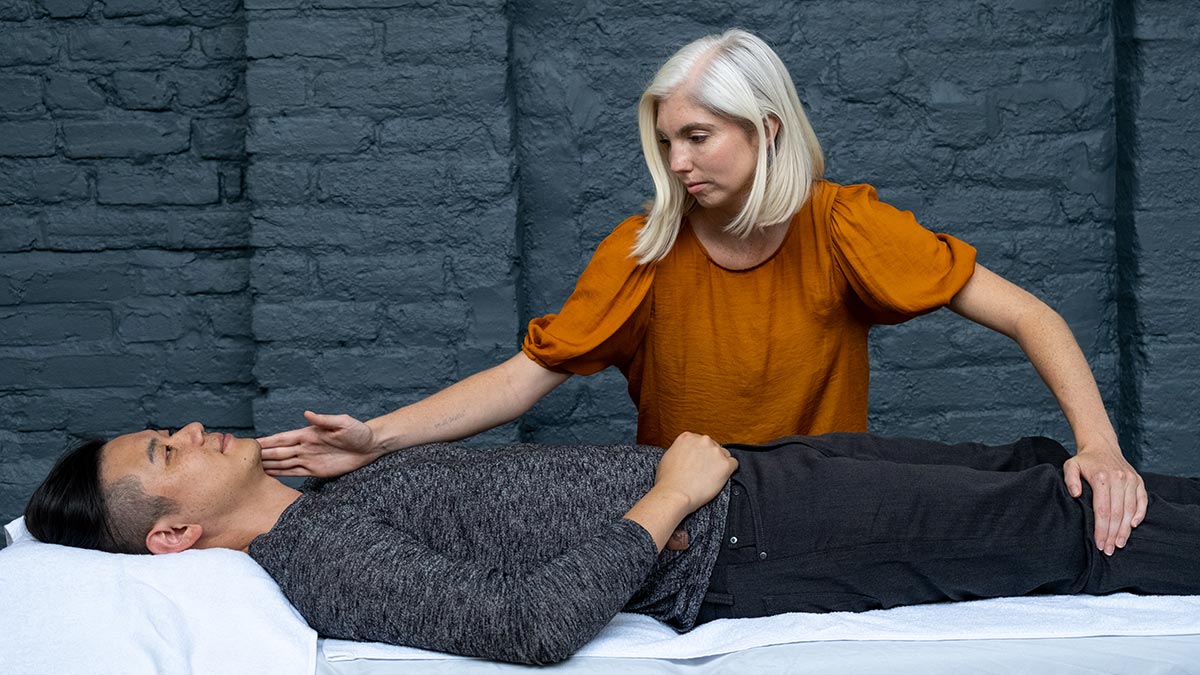What is Contact Care? The Hands-On Technique Designed to Heal Unresolved Trauma

Whether it’s celebrities raving about their Ayurvedic diets or the recent swathe of best-selling books on somatic breathwork, there’s no denying that holistic therapy is having a renaissance of sorts right now.
This broad form of alternative medicine stems from the theory of holism, which encourages us to think of the body not as separate, unrelated parts, but as (yep, you guessed it) an overall whole.
In recent months, you may have heard about Contact Care; the latest buzzy wellbeing trend designed to address whole-body pain and emotional trauma through the use of hands-on, targeted pressure applied to the skeletal system.
Originally hailing from New Zealand and now making waves in the UK and US, the method zeroes in on releasing deep-seated tension stored in the body, with the aim of helping you feel lighter, happier and pain-free.

What is Contact Care?
Contact Care is a fairly new form of bodywork therapy that focuses on finding and releasing tiny but disruptive tension spots in the body that have become ‘locked’ for either months or years because of past physical or emotional trauma.
Developed in the early 2000s by Dale Speedy, a New Zealand-based physiotherapist, the method views the skeletal system as having its own self-defence mechanism to safeguard the body against unexpected impacts, like accidents, sudden blows or emotional stress. According to Speedy, these incidents can cause bones to become tight and dysfunctional, as our bodies are ill-prepared to properly absorb the shock.
Whether it’s simply bumping your head on an open cupboard door or a more serious accident, Contact Care practitioners believe that both major and micro traumas can cause ‘flinchlocks’; memory points in the body where muscles or tissues tense up in response to shock. The point of the therapy is that these areas need to be manually ‘unlocked’ or released to ease pain and restore mobility.
“The skeletal system can hold onto both emotional and physical traumas,” says Leilani Bellamy, Contact Care practitioner and founder of healing clinic London Contact Care. “Sometimes bones can become stuck in these defensive states – keeping the body locked in a stiff fight-or-flight pattern.
“When this happens, other parts of the body start to compensate for the locked area, which causes pain and discomfort. The pain you feel might be far from the actual flinchlock thanks to this knock-on effect. Through gentle and targeted pressure, we focus on releasing these impacted bone structures so the bones and muscles can return to their original function.”
What are the benefits?
For many, Bellamy says Contact Care’s appeal lies in its ability to address deep-rooted physical traumas that may have persisted for years, often without resolution from conventional medical approaches.
“I personally came to the method after finding healing from my own shoulder injury,” she tells me. “I was amazed at how easily and gently my chronic pain was relieved – not just temporarily, but permanently. I often treat people who are suffering with similar chronic pain in the back, neck or other areas of the body. These aches and pains are stored trauma from incidents, many of which occurred in our childhood, which we may not even realise is affecting us.”
She notes that hands-on healing is particularly helpful for those struggling with pain, burnout, anxiety, sports injuries, headaches, insomnia, fatigue and migraines – or a combination of these issues. However, it’s worth mentioning that there’s currently a lack of specific peer-reviewed scientific research on this therapy. As with many holistic approaches, its effectiveness is primarily based on anecdotal experience and experimentation.

What does a Contact Care session involve?
My Contact Care session starts with Bellamy handing me a short form to fill out, where I mark any areas of physical pain or tension in my body and discuss emotional issues like sleep problems, anxiety or stress.
Then, she invites me to lie down on the treatment table, shoes off, in the most comfortable position that minimises pain or strain. For me, that’s in the foetal position. She then begins the treatment by gently holding my sternum and the upper part of my spine, guiding me through a series of deep, relaxing breaths.
It’s easy to be nervous when trying out any new kind of treatment, but the thing to know about Contact Care is that it’s designed to be safe, non-invasive and pain-free. Treatments are performed fully clothed, and the pressure applied is no more intense than what you’d experience in a standard Swedish massage.
With a light touch, Bellamy gently moves between joints to locate and assess the flinchlocks, adjusting my position as needed and ensuring I’m comfortable throughout.
“I’m searching for bones that feel heavy and immobile,” she tells me. “This is a key sign that a bone is trapped in a locked position.” When she finds an area that she suspects might be holding tension, she applies a more forceful pressure through her thumbs to the area to help manipulate the sticky point.
After the 60-minute session, I feel lighter and more relaxed, and I sleep well that night. Bellamy explains that there’s typically an ‘unravelling process’ after treatment, where the body returns to functionality over three to five days.
She advises me to avoid drinking alcohol, and says that clients can often experience energy surges, lightness and sometimes soreness due to the realignment process. The number of sessions needed depends on the severity of the injury or trauma, but she often recommends three or four treatments to get to the root cause.
“Every treatment is different and depends on what’s specifically happening in the body, but often people focus on treating a particular area while the root cause is somewhere else, so relief can be only temporary,” notes Bellamy. “The idea of Contact Care is to help find the starting point of your trauma so you have a solution that lasts.”


















